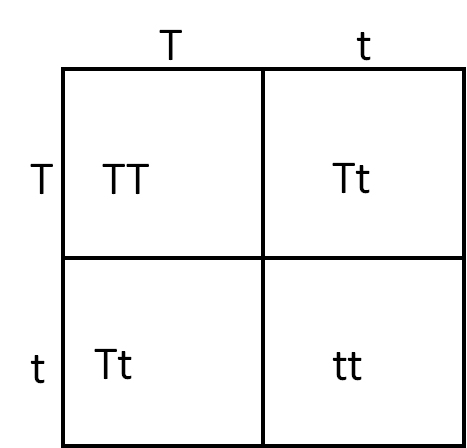Genetics Principles
Help Questions
Biology › Genetics Principles
The eye color brown is superior to blue. Linda has brown eyes and marries someone with blue eyes. Linda's father has blue eyes and her mother is homozygous dominant. What is the percent chance of Linda's children having blue eyes?
0.50
1.0
0.25
0.75
Explanation
Linda's mother has brown eyes: BB
Linda's father has blue eyes: bb
Using the pedigree (BB x bb), Linda has to be Bb (100%). Linda is marrying someone with blue eyes (bb). Doing the pedigree of Linda (Bb) and her partner (bb) gives you 0.50 Bb (brown eyes) and 0.50 bb (blue eyes).
Sharon has blonde hair. Her husband is heterozygous for brown hair, with brown being the dominant autosomal trait. What percent chance will their daughter have blonde hair?
50%
100%
25%
75%
0%
Explanation
The genotype for Sharon is rr, because blonde is a recessive trait therefore in order to have blonde hair she must be homozygous recessive. Her husband is Rr, because it states that he has brown hair, which is dominant, in addition to being heterozygous. When drawing out a punnet square, you will find the offspring will be Rr, Rr, rr and rr. Therefore, their daughter has 50% chance of having brown hair and 50% chance of having blonde hair.
The eye color brown is superior to blue. Linda has brown eyes and marries someone with blue eyes. Linda's father has blue eyes and her mother is homozygous dominant. What is the percent chance of Linda's children having blue eyes?
0.50
1.0
0.25
0.75
Explanation
Linda's mother has brown eyes: BB
Linda's father has blue eyes: bb
Using the pedigree (BB x bb), Linda has to be Bb (100%). Linda is marrying someone with blue eyes (bb). Doing the pedigree of Linda (Bb) and her partner (bb) gives you 0.50 Bb (brown eyes) and 0.50 bb (blue eyes).
The trait "tall" is dominant (T) while "short" is recessive (t). If two parents are both heterozygous for the trait and have a child, what is the probability that the child would be phenotypically short?
Explanation
The problem can be solved using the following Punnett square. Since short is recessive, the only genotype that will result in a short appearance is tt. tt occurs one time on the Punnett square, out of four possible combinations; therefore, there is a 1-in-4 chance of giving birth to a short child, or 25%.
The central dogma of molecular biology is the method by which cells transfer nucleic acids into functional molecules. Which of the following depicts the central dogma of molecular biology?
Explanation
The central dogma of molecular biology states that DNA is transcribed into RNA, which is then translated into protein.
The central dogma of molecular biology is the method by which cells transfer nucleic acids into functional molecules. Which of the following depicts the central dogma of molecular biology?
Explanation
The central dogma of molecular biology states that DNA is transcribed into RNA, which is then translated into protein.
The eye color brown is superior to blue. Linda has brown eyes and marries someone with blue eyes. Linda's father has blue eyes and her mother is homozygous dominant. What is the percent chance of Linda's children having blue eyes?
0.50
1.0
0.25
0.75
Explanation
Linda's mother has brown eyes: BB
Linda's father has blue eyes: bb
Using the pedigree (BB x bb), Linda has to be Bb (100%). Linda is marrying someone with blue eyes (bb). Doing the pedigree of Linda (Bb) and her partner (bb) gives you 0.50 Bb (brown eyes) and 0.50 bb (blue eyes).
Sharon has blonde hair. Her husband is heterozygous for brown hair, with brown being the dominant autosomal trait. What percent chance will their daughter have blonde hair?
50%
100%
25%
75%
0%
Explanation
The genotype for Sharon is rr, because blonde is a recessive trait therefore in order to have blonde hair she must be homozygous recessive. Her husband is Rr, because it states that he has brown hair, which is dominant, in addition to being heterozygous. When drawing out a punnet square, you will find the offspring will be Rr, Rr, rr and rr. Therefore, their daughter has 50% chance of having brown hair and 50% chance of having blonde hair.
The trait "tall" is dominant (T) while "short" is recessive (t). If two parents are both heterozygous for the trait and have a child, what is the probability that the child would be phenotypically short?
Explanation
The problem can be solved using the following Punnett square. Since short is recessive, the only genotype that will result in a short appearance is tt. tt occurs one time on the Punnett square, out of four possible combinations; therefore, there is a 1-in-4 chance of giving birth to a short child, or 25%.
The trait "tall" is dominant (T) while "short" is recessive (t). If two parents are both heterozygous for the trait and have a child, what is the probability that the child would be phenotypically short?
Explanation
The problem can be solved using the following Punnett square. Since short is recessive, the only genotype that will result in a short appearance is tt. tt occurs one time on the Punnett square, out of four possible combinations; therefore, there is a 1-in-4 chance of giving birth to a short child, or 25%.




